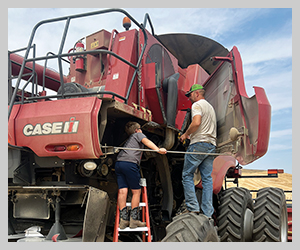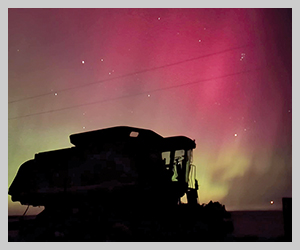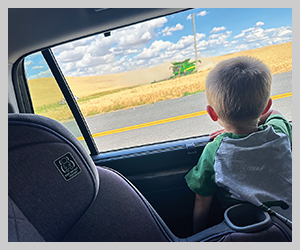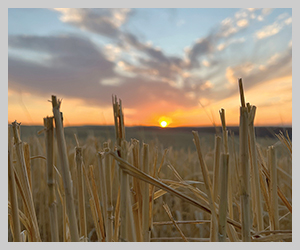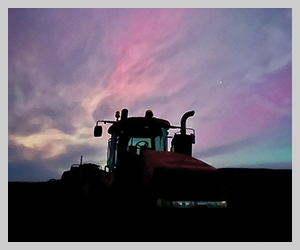
A few years ago, when I purchased my Ranger Tug, I started dreaming about the places I could visit beyond where roads and airplanes could take me! The breaching of the Snake River dams is in almost every Wheat Life issue. As a farm ground owner, I am quite familiar with the Snake and its valuable assets, such as transportation of goods and services and power generation. I’m concerned a few people may get their way and breach these dams, so I offer a different perspective that few people get to experience—a trip by boat on the Snake River.
In 2020 with my sweetie, Gayle (aka deckhand), we load my 150 hp diesel motor tug, Ruby Rose, with 80 gallons of fuel, 30 gallons of water, food, drinks and just about anything else we might need and head to Boyer Park and Marina.
While launching Ruby Rose, I always get a few people admiring the boat. It often takes longer to launch because of it, but I see it as an opportunity to pick other people’s brains for tips on the unknown. And this trip is no exception! First tip, Little Goose Bay is the biggest and most protected bay on the entire trip. We shove off and begin our adventure.
Just a couple of miles from the ramp, all boats disappear. The miles roll by at our cruising speed of 12 knots. Thirty miles later, as we pull into Little Goose Bay; we see some of our new friends. Back at Boyer Park and Marina, they promised us a cold beer after dinner, and we gladly accepted the offer as it was a constant 103-104 degrees all day. Fortunately, Little Goose Bay is a deep canyon that offers shade by 7 p.m. After a couple of well wishes, river information and exchanged phone numbers, we motor back to our boat in our dingy for a night’s rest.
We sleep in as the cool morning breeze blows through the boat. I realize that we have six miles to get to Little Goose Dam for our 9:30 lock time, and it’s 9 a.m. I don’t think we can make it in time, and I’m right! The locks are not “on demand” for pleasure craft, but stick to a schedule of 6 a.m., 9 a.m., 12 p.m., 3 p.m., 6 p.m. and 9 p.m. upstream and 30 minutes later downstream. So, we wait for three long hours in the blistering heat. We take quick dips, hanging on to the swim ladder so the current doesn’t take us on a journey of no return. It’s surprising how cold the river is in the very last days of July, even in the pools.
We pass through the gate and slip down the river, listening to our favorite music and pausing every 45 minutes to cool down with a quick dip. I putter along at six knots, letting the auto pilot take us through the canyons and cliffs, past barging facilities and an occasional farm. A few hours later, we pull into the marina at Lyons Ferry. We love to support local businesses, and we do our part by having lunch and ice cream before we head to an inlet on the other side. This is where the Palouse River enters the Snake River. It’s windy and choppy from all the boats pulling wake boarders, surfers and skiers. We take a long nap and get rocked to sleep in the heat, but when we get up, they’re still out there. We look for better place to anchor and see one just east of us. By 8:30 p.m., the boats finally thin out, bringing peace, quiet and dinner. The peacefulness is unmatched while you are on the water during the evening hours. It reminds me of harvest, when the last piece of equipment shuts down, and you can hear your neighbor talk a mile away.
The next day, we decide to quickly make it to the Tri-Cities, watching for places to stay on the trip back. Lake Sacajawea, behind Ice Harbor Dam, is the only pool where we consistently see lots of recreational boaters. The river below Ice Harbor is unlike the rest of the river. It is very shallow with a dredged depth of only 14 feet and a width of 200 feet, just enough for two barges to pass. Once we enter the Columbia, though, we are impressed with the amount of water flowing through. A good current of three knots, an average depth of 30 feet and 3,000 feet across!
We pull into the Port of Kennewick on Clover Island and call friends we met when we launched. We have takeout at their place—its COVID season. We were going to spend a couple of nights at Clover Island, but found it too noisy with people and their big, loud boats. So, the next morning, we head back up the river to Fish Hook Park. At Ice Harbor Dam, we share a lock with a small barge. The captain radios us and asks us to move forward in case anything goes wrong. Wondering what could go wrong, I move as instructed.
The campground at Fish Hook Park is closed while the park is being remodeled. We tie up to the tippy, goose dropping-covered dock for the night. We thought we had it to ourselves, not even thinking about the wildlife that has taken over. We even have a raccoon stop by the boat for snack while we sleep. At 1 a.m., I carefully shoo him out. I’m sure he left with a gut ache as two pounds of cherries, three avocados, two candy bars, one apple, a few stick of chewing gum and two cinnamon rolls are gone! Note to self—do not leave the cabin door open at night.
The next morning, we head towards Lower Monumental Dam. Since we are the only boat entering the lock, I took the first bollard, which is next to where the water enters the lock for filling. This presents us with the only hair-raising event for the entire trip. These locks were primarily constructed for barges and tugs, not recreational craft. In the locks, you are required to be attached, but not securely tied, to the floating bollards. That way, if the bollard hangs up in its channel, you simply let go of the line. That’s important, because if you can’t release your boat from the bollard, it will lift your craft out of the water or drag it under. We are talking about 100 feet of lift, and the locks average about 85 by 700 feet, so there is huge amount of water rushing in. Our problem is the inward rushing water. We’re going up about four feet every 10 seconds, and the boiling water pushes us away from the wall. We are trying to maintain our position with a stern line and the bow thruster, but the bow keeps getting further away from the wall. I yell to Gayle to release the bollard, but it’s noisy, and she can’t hear me. She can’t hold on, and the line gets stripped through her hands, giving her some minor rope burns. Now we are free floating, crosswise, in a whirling blender and moving rapidly for the other wall. I back the boat towards the wall we’ve just left. I know I must turn the boat parallel with the lock, but that’s not easy. The lock sure seems a lot narrower than 85 feet. My length is about 28 feet. It is a crazy combination of forward, reverse and side to side thrusters. Now I know what that barge captain back at Ice Harbor meant by “go wrong.”
Behind this dam, we notice several irrigated farming operations near the water. I thought these farmers were crazy to farm corn in such a remote location, taking water away from the salmon! We always try to anchor somewhere we can get off the boat and go for a walk, so we pull into a bay near these farms.
After dinner, we climb into our dingy and paddle over to a small dock. As we step onto land, we get it! These are wildlife areas created by the U.S. Army Corps of Engineers! It’s amazing to see all the effort and money put into areas like this along the river. We hear a big diesel generator purring, pumping water into sprinkler heads; there are nearly 100 circles. Many of the circles have trees planted in them, and where there is some soil, there is field corn. There is abundant wildlife here.
The rest of the trip back is uneventful.
In retrospect, it really surprises me how many barges were on the river, confirming that the rivers in the Pacific Northwest are working rivers. And we need every last bit of hydropower the dams produce. I realize that if the dams were removed, it would be a mecca for jet boats roaring up and down the river or…maybe just kayakers. But that would be very few people indeed, as there is little public access to the river. I have often said that environmentalists want to lock things up so tight that the only ones who have access to the river are the able-bodied enthusiasts. Fortunately, now it is very accessible, whether you have your own boat or take a river cruise in a wheelchair. I highly recommend you get to know your backyard, down the river!
Rod Heimbigner grew up on his family’s farm in Ritzville. He was a certified crop advisor for The McGregor Company before retiring from LifeFlight Network. Gayle Anderson spent nearly 30 years on a farm near Genesee, Idaho, and is a ag advocate/lifestyle writer through her blog at www.swheatfarmlife.net. She retired from Washington State University and writes for Home and Harvest magazine.



